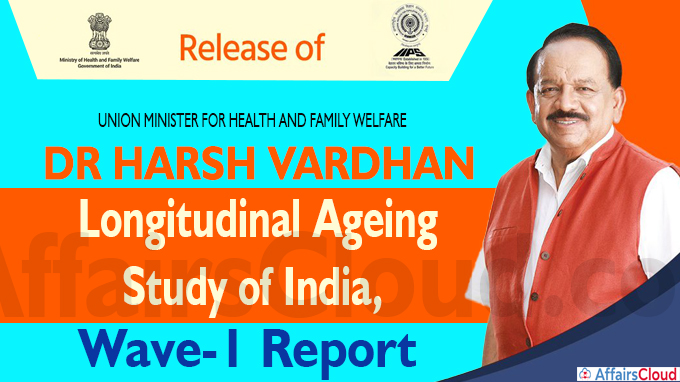
- This report is also a step towards Ayushman Bharat Yojana which focuses on expansion of the healthcare facilities.
- The information obtained from LASI has covered four domains viz. Health, Health care and Health care financing, Economic, and Social.
- It should be noted that LASI is a Government of India’s (GoI) initiative towards Better Health Care for Elderly People.
Who conducted LASI?
It was undertaken by the National Programme for Health Care of Elderly (NPHCE) under MoH&FW through International Institute for Population Sciences, (IIPS), Mumbai (Maharashtra) in collaboration with Harvard School of Public Health, University of Southern California, USA, Dte.GHS, United Nations Population Fund (UNFPA) and National Institute on Ageing.
General Info about LASI:
–It covered a baseline sample of 72,250 individuals aged 45 and above and their spouses including 31,464 elderly persons aged 60 and above and 6,749 oldest-old persons aged 75 and above from all States and Union Territories (UTs) of India
–The state of Sikkim has not been covered under this survey.
–The main LASI instrument consists of two sections: a Household Survey and an Individual Survey.
–It is a biennial survey.
Requirement of LASI:
- As per 2011 census, the 60+ population accounted for 8.6% of India’s population, accounting for 103 million elderly people. Growing at around 3% annually, the number of elderly population will be tripled to 319 million in 2050.
- 75% of the elderly people suffer from one or the other chronic disease.
- 40% of the elderly people have one or the other disability and 20% have issues related to mental health.
- On the global front, the share of older people aged 60 years and above increased from 9.2% in 1990 to 11.7% in 2013 and is expected to reach 21.1% by 2050.
- Elderly persons are at the highest risk of contracting the COVID-19.
Taking all the above mentioned factors in consideration, the evidence from the report will be utilized towards the further strengthening of (NPHCE) as older people, and people of all ages with pre-existing medical conditions develop serious illness more often than others.
Key Evidences from LASI:
About 45 million have cardiovascular disease and hypertension and about 20 million suffer from diabetes, and 24% of the elderly have difficulty in performing daily functions such as walking, eating, toilet etc.
Cardiovascular diseases (CVDs)
- The prevalence of CVDs increases with age.
- More than a half of elderly age 60 and above in the states/Union Territories (UTs) of Goa (60%), Kerala (57%), Chandigarh (55%), Andaman & Nicobar (51%), and Jammu & Kashmir (51%) have been diagnosed with CVDs.
Vision, Nutrition & Depression:
- Andhra Pradesh (AP) topped the Measured prevalence (%) of low vision (near and/or distance) among elderly age 60 and above with 66.4%.
- Uttar Pradesh (UP) topped the Prevalence (%) of blindness among elderly age 60 and above.
- Chhattisgarh topped in the prevalence of undernutrition (underweight) among older adults aged 45 and above.
- Chandigarh has maximum prevalence of overnutrition (overweight/obesity) among older adults aged 45 and above.
- Jammu & Kashmir has the highest percentage (54.3%) of elderly age 60 and above with depressive symptoms.
- Madhya Pradesh has maximum prevalence of major episodic depression with 17% †
Other Disease:
–About a third (32%) of elderly age 60 and above have been diagnosed with hypertension, 5.2% were diagnosed with chronic heart disease and 2.7% with stroke.
–The self-reported prevalence of diabetes mellitus among older adults age 45-59 is 9% and among the elderly age 60 and above is 14%,
–The prevalence of asthma, bronchitis is higher among elderly age 60 and above than in older adults aged 45-59.
–Around 8% of elderly age 60 and above reported chronic lung diseases. These are more prevalent in the states/UTs of Rajasthan (15%), Puducherry (13%), Kerala (12%), West Bengal (11%) and Karnataka (10%),
–Around a quarter of the elderly age 60 and above have multi-morbidities (23%) compared with 13% among older adults aged 45-59.
- The prevalence of multi-morbidity conditions among the elderly age 60 and above is much higher in the states/UTs of Kerala (52%), Chandigarh (41%), Lakshadweep (40%), Goa (39%) and Andaman & Nicobar Islands (38%).
How data collected for LASI?
It was commissioned in 2016 by MoH&FW and the LASI field survey was conducted across 34 states from April 2017 to December 2018.
The LASI has used the Computer Assisted Personal Interviewing (CAPI) technology for data collection, quality control, and Geographic Information System (GIS). The CAPI technology is funded through a pilot grant from Harvard’s Program on the Global Demography of Aging.
Additional Info:
–The introduction of LASI enables India to have a cross-country comparison of these surveys.
–Longitudinal Ageing Study in other countries include Health and Retirement Study (HRS) in the United States, Korean Longitudinal Study on Ageing (KLoSA), the Japanese Study of Aging and Retirement (JSTAR), and the China Health and Retirement Longitudinal Study (CHARLS).
–In 2010-2011, the LASI team conducted a pilot study across four Indian states: Karnataka and Kerala in the south, and Punjab and Rajasthan in the north.
After the release of the LASI report, a first Workshop to address Comprehensive Geriatric Care Assessment & Delivery through Various National Health Programmes was also held virtually.
Other Participants:
Dr. K.S. James, Director IIPS, Ms.VandanaGurnani, AS & MD-NHM, Prof. (Dr.) Rajiv Garg, Professor of Excellence, Sh. Vishal ChauhanJoint Secretary-NCD, Dr.Gowri N. Sengupta, ADG- NPHCE were also present at the event.
Click Here for Official Report
Recent Related News:
i.On November 12, 2020 The Union Ministry of Health & Family Welfare (MoHFW) launched a 3 month accelerated SAANS (Social Action and Awareness to Neutralise Pneumonia Successfully) campaign to reduce childhood pneumonia deaths.
ii.On October 14, 2020 Dr Harsh Vardhan virtually launched the Second Phase of “Thalassemia Bal Sewa Yojana” from Nirman Bhawan, New Delhi. It will benefit underprivileged patients.
About Ministry of Health & Family Welfare (MoHFW):
Harsh Vardhan Constituency– Chandni Chowk, New Delhi
Minister of State (MoS)– Ashwini Kumar Choubey